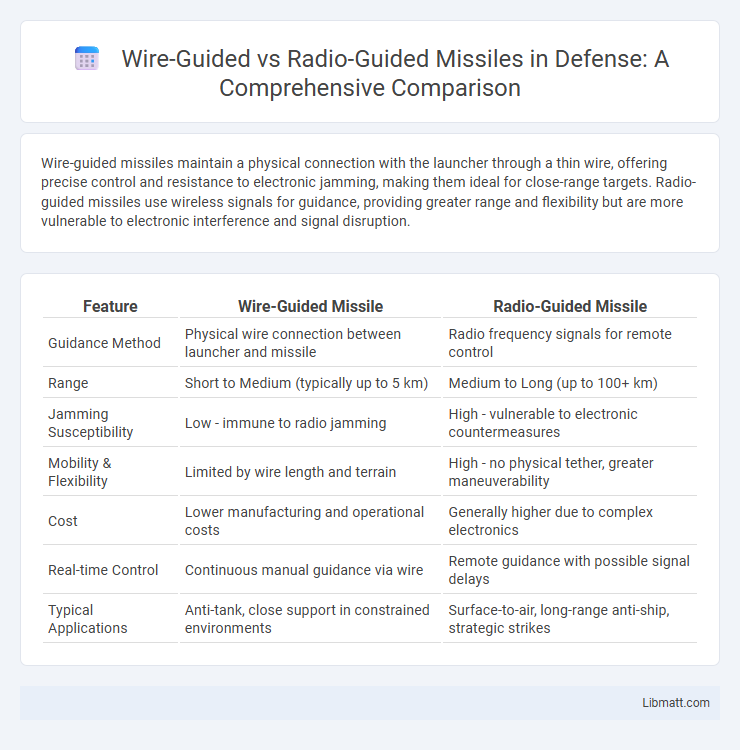Wire-guided missiles maintain a physical connection with the launcher through a thin wire, offering precise control and resistance to electronic jamming, making them ideal for close-range targets. Radio-guided missiles use wireless signals for guidance, providing greater range and flexibility but are more vulnerable to electronic interference and signal disruption.
Table of Comparison
| Feature | Wire-Guided Missile | Radio-Guided Missile |
|---|---|---|
| Guidance Method | Physical wire connection between launcher and missile | Radio frequency signals for remote control |
| Range | Short to Medium (typically up to 5 km) | Medium to Long (up to 100+ km) |
| Jamming Susceptibility | Low - immune to radio jamming | High - vulnerable to electronic countermeasures |
| Mobility & Flexibility | Limited by wire length and terrain | High - no physical tether, greater maneuverability |
| Cost | Lower manufacturing and operational costs | Generally higher due to complex electronics |
| Real-time Control | Continuous manual guidance via wire | Remote guidance with possible signal delays |
| Typical Applications | Anti-tank, close support in constrained environments | Surface-to-air, long-range anti-ship, strategic strikes |
Introduction to Missile Guidance Systems
Missile guidance systems utilize different technologies to direct projectiles accurately toward their targets, with wire-guided and radio-guided being two primary methods. Wire-guided missiles maintain a physical connection to the launcher via spooled wire, ensuring secure control signals without electronic interference, ideal for short-range engagements. Radio-guided missiles employ wireless radio frequency signals for guidance, offering greater range and flexibility but potentially facing signal jamming threats, making Your choice dependent on mission requirements and operational environment.
Wire-Guided Missiles: Overview and Principles
Wire-guided missiles use a physical wire that connects the launcher to the missile, transmitting real-time control signals to guide its trajectory. This system offers high resistance to electronic countermeasures and ensures precise targeting by maintaining a direct communication link throughout the missile's flight. Your choice of wire-guided missiles provides enhanced accuracy in environments with heavy radio interference or jamming threats.
Radio-Guided Missiles: Overview and Principles
Radio-guided missiles use electromagnetic signals to track and engage targets, offering greater flexibility and longer ranges compared to wire-guided systems. These missiles rely on radio frequency commands or active radar homing to adjust their flight path in real time. Your choice of missile guidance depends on mission requirements, with radio guidance excelling in beyond-line-of-sight scenarios and complex environments.
Key Differences Between Wire-Guided and Radio-Guided Missiles
Wire-guided missiles rely on physical cables connecting the missile to the operator, providing secure and interference-free control, making them ideal for short-range, precise targeting. Radio-guided missiles use wireless signals for guidance, allowing longer range and greater mobility but are vulnerable to electronic jamming and signal interception. Your choice between these depends on mission requirements such as range, battlefield conditions, and countermeasure susceptibility.
Advantages of Wire-Guided Missile Technology
Wire-guided missile technology offers enhanced resistance to electronic jamming and signal interception, ensuring reliable guidance in contested electromagnetic environments. The physical connection via wire provides real-time control and feedback, enabling precise targeting even in complex terrain and dense urban settings. Furthermore, wire-guided systems typically exhibit lower susceptibility to countermeasures compared to radio-guided counterparts, enhancing mission success rates in modern warfare.
Advantages of Radio-Guided Missile Technology
Radio-guided missile technology offers significant advantages including extended range and enhanced flexibility in targeting compared to wire-guided systems. You benefit from the ability to engage fast-moving or distant targets without physical connections, increasing operational versatility in diverse combat environments. This technology also enables real-time adjustments and improved signal resilience, ensuring higher accuracy and mission success rates.
Limitations and Challenges of Wire-Guidance
Wire-guided missiles face significant limitations including restricted range due to the physical length of the wire and vulnerability to wire breakage during high-speed maneuvers or rough terrain. Signal interference or wire damage can result in loss of control, reducing reliability in complex combat scenarios. Your operation may be hindered by slow response times as the missile remains tethered, limiting tactical flexibility compared to radio-guided systems.
Limitations and Challenges of Radio-Guidance
Radio-guided missiles face limitations such as susceptibility to electronic jamming and signal interference, which can disrupt target tracking and reduce accuracy. Environmental factors like weather conditions and line-of-sight obstructions further challenge the reliability of radio signals. Your defense strategy may be compromised if adversaries exploit these vulnerabilities, highlighting the need for robust countermeasures.
Applications and Use Cases in Modern Warfare
Wire-guided missiles are primarily used for short-range, precise targeting against armored vehicles and fortifications, ensuring minimal electronic interference and secure communication between the launcher and missile. Radio-guided missiles excel in longer-range engagements where flexibility and dynamic target tracking are essential, making them ideal for anti-aircraft defense and beyond-visual-range attacks. Your choice between these systems depends on mission requirements, such as the need for stealth and jamming resistance with wire-guided or extended range and adaptability offered by radio-guided missiles.
Future Trends in Missile Guidance Technologies
Wire-guided missiles, with their inherent resistance to electronic countermeasures, face limitations in range and maneuverability compared to radio-guided systems that offer extended reach and real-time target updates via secure data links. Emerging trends emphasize the integration of artificial intelligence and autonomous navigation, enhancing radio-guided missiles' precision and adaptability in complex electromagnetic environments. Hybrid guidance systems combining wire, radio, and satellite inputs are being developed to optimize missile accuracy, survivability, and operational flexibility in future combat scenarios.
wire-guided vs radio-guided missile Infographic

 libmatt.com
libmatt.com